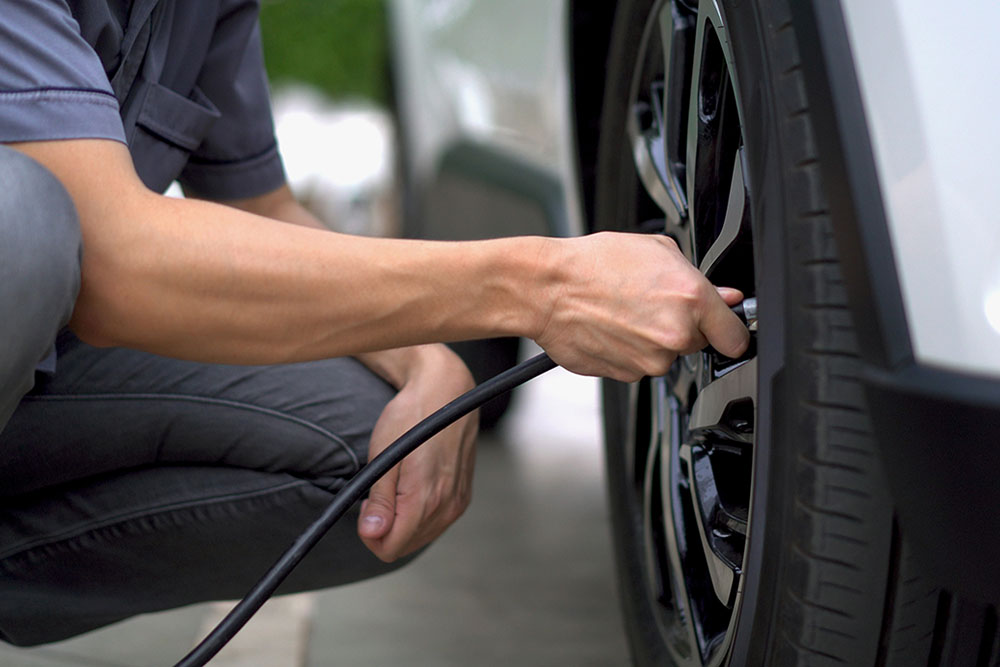Top 5 Reasons To Get Your Tire Inflation Checked This Month

One of the easiest ways to extend the life of your vehicle’s tires (and save money on fuel) happens to be one of the easiest things to forget.
According to Bridgestone America, properly inflated tires provide faster steering response, last longer, and help prevent tire blowouts.
And there’s one inexpensive, indispensable tool to make sure your vehicle tires meet minimum inflation criteria: the humble tire gauge.
Top 5 Reasons To Check Tire Inflation Monthly
- Under-inflated tires do not maintain their proper shape on the road and bend more when rolling. This causes tires to overheat and wear out faster. Under-inflation can cause your tires to ride on the thin sidewall and cause blowouts.
- Over-inflated tires can reduce traction, accelerate tread wear and lower a tire’s ability to absorb impacts.
- Low tire pressure wastes gas. When tires are low on air, it piles pressure on your engine to push harder; this causes your vehicle to burn more fuel. According to the Department of Transportation, over 5 million gallons of fuel are wasted every day because of low tire pressure. This results in over 2 billion estimated gallons of gas lost annually.
- Keeping your tires properly inflated improves your fuel economy and avoids replacing tires more frequently. This is a simple maintenance chore that can be sorted out with a tire gauge.
- You cannot always rely on a tire pressure monitoring system (TPMS) to tell you when you need to pump your tires. Most systems only warn you when the pressure is 25 percent below a manufacturer’s recommended tire pressure. This is why it is crucial to check your tires manually.
Common types of tire inflation gauges to choose
- A stick/pencil-type gauge consists of a metal outer shell attached to a chuck valve (the end that fits over the air valve on the tire) and inner measuring rod. When applying pressure through the valve, the inner rod extends according to the pounds per square inch (psi). The length the rod reaches before meeting the outer shell indicates the tire pressure.
- An analog/dial gauge has a clocklike face and a needle that points to the correct psi. Most are small and compact, while others have additional features like extension hoses and dual-scale dials. When attaching the gauge valve to the tire, the needle rises to the correct pressure and stays there until you hit the bleeder valve (reset button) which releases the captured air.
- A digital gauge features a clear readout on an LCD screen. It is the most accurate of all gauges and can read pressure to a small fraction of a pressure unit. They are made from stainless steel or aluminum and have crack-resistant plastic faces to protect them from drops, shocks, hazardous chemicals and flying debris. Make sure you have a fresh battery to provide accurate readings.
Checking tire pressure On The Road
The way you check inflation has a lot to do with the reliability of results. Here are some guidelines provided by Bridgestone.
- Jot down the tire’s recommended inflation level, known as “pounds per square inch” or PSI. Inflation levels differ by tire and vehicle. Look for a sticker in the door jamb on the driver’s side of the vehicle, or refer to your vehicle manual.
- Check pressure when tires are cold. Tires are accounted to be cold if the vehicle is parked for at least three hours or driven less than a mile at moderate speed, Bridgestone stated.
- Unscrew the tire valve cap and press the gauge chuck end firmly into the tire valve stem. If there is a sound of escaping air, press the gauge firmly down to create a hiss-proof seal.
- Read the tire pressure and compare it with the recommended tire pressure reading. For manual gauges, the level of air pressure shows on the small pop-up bar. Digital gauges display a pressure reading in numbers. For either read-out, make sure to compare those readings with manufacturer recommended tire pressure settings.
- Add air as needed, but be careful to avoid overfilling. Are you using a compressor at a gas station? Remember to park where the filling hose can reach all four tires.
- “Hot” tires require a higher pressure level; this includes tires driven more than a mile in the past three hours. According to Bridgestone, hot tires require a few extra pounds of pressure. The pressure inside a tire tapers off as the tire cools. Recheck pressure on cold tires.
- Release pressure on overinflated tires. Let out air from a cold tire that exceeds the recommended inflation level by pushing down on the valve stem core–that thin metal cylinder underneath the tire cap, centered inside the tire valve. Be careful not to damage the core; use a gentle touch to release air pressure. Check tire pressure again after release to confirm proper inflation.
Repeat this process monthly to increase tire life. Tires tend to leak air slowly over time and can lose up to 3 PSI per month. Cold and hot weather also affect tire pressure.
A monthly check can keep your tires operating properly around town and on any upcoming road trips.